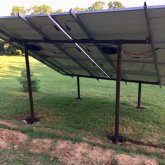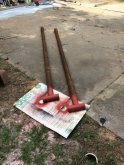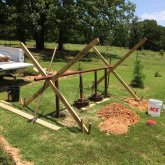I put this system in June 2019, my first. We have great grid tie laws in Arkansas. Full credit for any excess that goes onto the grid. I get $$ credit on my account monthly with monthly energy cost adjustment. This credit pays for my monthly service access fee and a bit more. I oversized, planning to retire in a few years and expect to be using more power once I am at home all of the time. The mount is fixed angle. The substructure, I made from steel drill pipe and then used Iron Ridge mounting rails and hardware. I have 8, 4 port APSystems QS1 microinverters, peak total rating 9.6Kw. From the house is a 240v 50 amp circuit coming from my main panel, with outside disconnect. At the array field I have a post with breaker box and local 120v and 240v outlets. All normal 240v AC wiring ran right to the grid tie inverters without any "solar" gear in the system until I connect 240v to the microinverters. I have 32 older designed (but never used) SunPower P17-340 panels. On a cool sunny day I can hit 10Kw at midday. I am making about 1500 KWhr per month average.

Sorry little tree, but you will have to go.

Local 240v circuit runs to the inverters under construction.


Sorry little tree, but you will have to go.

Local 240v circuit runs to the inverters under construction.

Last edited:




